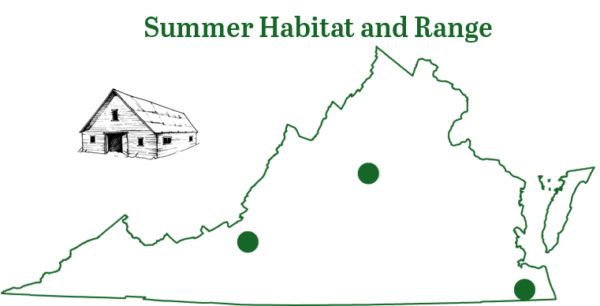Brazilian Free-tailed Bat. © Merlin D. Tuttle, Bat Conservation International.
Brazilian Free-tailed Bat. Illustration by Brittany Fernald.
Fact File
Scientific Name: Tadarida brasiliensis
Classification: Mammal, Order Chiroptera
Conservation Status:
- Occurs only incidentally in Virginia.
Identifying Characteristics
The Brazilian free-tailed bat, also known as the Mexican free-tailed bat, is easily distinguished by its tail that extends for about half its length beyond the tail membrane. Adults measure 3.5–4.0 inches in length and weigh 0.4–0.5 ounces. The fur is short, velvety, and colored a brownish gray or dark brown. Some individuals have patches of white scattered throughout their fur. The ears are short, wide, thick, leathery, and separated in the middle of the forehead by a narrow gap. The wings are long and narrow, and the hairs on the toes extend beyond the claws. This species has a distinct musk odor that can reveal their roost site.
Habitat
In the south, this species is found roosting in buildings, bridges, schools, and other man-made structures, but in the west it is associated with caves where it forms huge colonies.
Diet
Free-tailed bats feed on winged ants, wasps, beetles, midges, and small moths.
Distribution:
This is a bat of the extreme south and western states with the range extending into Central and South America. Until recently, there were two records for this species in Virginia. Two individuals were netted at a site in the mountains of Virginia west of Blacksburg. A single individual was identified from a specimen submitted to the Health Department from southeast Virginia. In July 2014, a pup was rescued from an apartment complex in Charlottesville and sent to a wildlife rehabilitator. The presence of a maternity colony this far north suggests the species may be expanding its range.

Reproduction
A single young is usually born in late May to early June, but rarely twins are born. The gestation period is 77–84 days, and young start to fly at about five weeks of age.
Colony
Bracken Cave in Texas houses the world’s largest bat colony of 20 million individuals. Brazilian free-tailed bats are a major tourist attraction in Austin, Texas, where an estimated 6 million individuals inhabit the Congress Avenue Bridge.
Last updated: January 19, 2024
ShopDWR
Order your copy of A Guide to the Bats of Virginia, along with more gear, guides, and gifts!
Visit ShopDWRThe Virginia Department of Wildlife Resources Species Profile Database serves as a repository of information for Virginia’s fish and wildlife species. The database is managed and curated by the Wildlife Information and Environmental Services (WIES) program. Species profile data, distribution information, and photography is generated by the Virginia Department of Wildlife Resources, State and Federal agencies, Collection Permittees, and other trusted partners. This product is not suitable for legal, engineering, or surveying use. The Virginia Department of Wildlife Resources does not accept responsibility for any missing data, inaccuracies, or other errors which may exist. In accordance with the terms of service for this product, you agree to this disclaimer.

